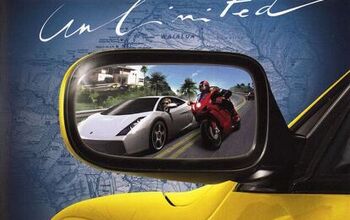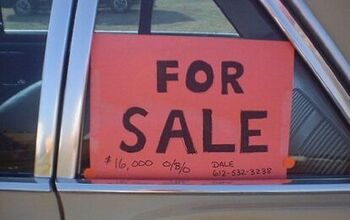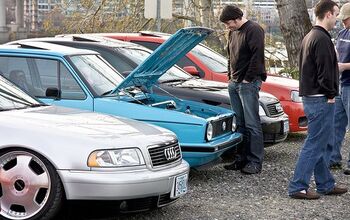How to Buy a Used Car – Pt. 2: The Test Drive
Schedule the test drive for a time when there’s no rush. If it’s bad weather, reschedule. Take a little notebook, write a quick check list based on this article, and make notes. When you approach the car's owner, be friendly, polite and courteous. Do NOT try to “beat them down” to get a better deal. While you have every right to ask direct questions, you have no more right to insult their car than one of their children.
First, check the tires. Pull the steering wheel all the way to the left (and then right) so you can see the entire tread. Uneven tire wear– marks on the side or deep grooves in the middle– may indicate suspension issues. And nothing screams “lemon” louder than cheap, bald or strangely worn rubber.
Next, open and close all the doors several times, including the trunk and hood. Check for paint on the hinges and moldings. If a door creaks, it’s usually no big deal. If a door has trouble closing, it can signal anything from a broken hinge to frame damage.
On the driver’s side, make sure that the VIN sticker or VIN plate hasn’t been removed.
Have a quick look at the panel gaps, especially the hood and trunk. Unless you’re looking at an old Land Rover, they should all be even. Check for water leakage in the trunk. Damp and/or a mildew smell often indicates problems underneath.
When you climb aboard, don’t be put off by worn seats or busted radios. Most interior surfaces and parts can be repaired and/or replaced easily and cheaply.
Lower the window and fire up the car– a few times. Do you hear any tapping or pinging sounds, or does it kick over with a smooth ‘vrooom’ and settle into an easy, quiet idle?
Test all the buttons and switches including the radio stations. If the owner listens to aggressive music, chances are the car’s been thrashed.
Flip on the A/C. It should kick out cool air within fifteen seconds of ignition. Same goes for heat. (HVAC repairs can run as high as $500 to $1500.) When you’re on the road, test both of them again to make sure the temperature and fan speed are constant.
Finally, turn the steering wheel all the way to the left and right. The motion should be seamless and silent. If there’s a lot of resistance, or the force required is uneven, the steering system may need anything from power steering fluid (cheap) to a power steering pump assembly (moderate) to a new rack (first born).
Now put the car in gear. Aside from a few models (older Mercedes in particular), a late or rough shift from park indicates that the car’s transmission may soon give up the ghost. If you experience rough or late shifting, you’re done.
Brake force should be quick and constant. Unless the brakes have been recently replaced (ask), you shouldn’t hear any squeaking sounds.
Drive the car through a variety of traffic conditions, inclines and speeds, for at least a half hour. When going uphill, take your foot off the accelerator for a moment. Coast downhill as well. If the car’s transmission hunts, clunks or has trouble catching, the vehicle probably has a transmission or linkage issue.
If you hear a lot of ‘clacking’ or other unusual engine noises on initial acceleration, the engine’s components may need attention. If there’s an oil gauge, keep an eye on it. It should show approximately 25 to 80 psi during acceleration, and 10 to 20 when idling. The coolant temperature should hit a fixed point within ten minutes and never move.
After about twenty minutes of driving, take the car to a gas station. Keep the engine on. Open the hood and the gas cover release to make sure they’re in proper working order. If you know where the transmission dipstick is (and it’s a damn good idea to find out), check the level. Does it have bubbles? If the fluid is brown or black, it could be a sign of future transmission issues.
Turn the vehicle off and check the oil. If it’s not between the marks (too low or too high) or discolored, you’re done.
Finally, get a wet paper towel, wipe the dirt off the relevant reservoirs and check the coolant, power steering and brake fluids to make sure they’re at their proper levels. S-l-o-w-l-y open the reservoir tank and check the coolant's color. If it’s a multi-colored muck or brownish black, note it down.
By this point, you should have a pretty good idea whether your next step is towards purchase or home sweet home. If you’re blowing it off, thank the owner politely and leave promptly, without engaging in any further discussion whatsoever. ("It's not what I had in mind.") If you’re ready to move forward, it’s time to schedule a professional inspection.
[Mr. Lang invites TTAC readers to share their
used car test drive advice below.]
More by Steven Lang
Latest Car Reviews
Read moreLatest Product Reviews
Read moreRecent Comments
- Zipper69 "At least Lincoln finally learned to do a better job of not appearing to have raided the Ford parts bin"But they differentiate by being bland and unadventurous and lacking a clear brand image.
- Zipper69 "The worry is that vehicles could collect and share Americans' data with the Chinese government"Presumably, via your cellphone connection? Does the average Joe in the gig economy really have "data" that will change the balance of power?
- Zipper69 Honda seem to have a comprehensive range of sedans that sell well.
- Oberkanone How long do I have to stay in this job before I get a golden parachute?I'd lower the price of the V-Series models. Improve the quality of interiors across the entire line. I'd add a sedan larger then CT5. I'd require a financial review of Celestiq. If it's not a profit center it's gone. Styling updates in the vision of the XLR to existing models. 2+2 sports coupe woutd be added. Performance in the class of AMG GT and Porsche 911 at a price just under $100k. EV models would NOT be subsidized by ICE revenue.
- NJRide Let Cadillac be Cadillac, but in the context of 2024. As a new XT5 owner (the Emerald Green got me to buy an old design) I would have happy preferred a Lyriq hybrid. Some who really like the Lyriq's package but don't want an EV will buy another model. Most will go elsewhere. I love the V6 and good but easy to use infotainment. But I know my next car will probably be more electrified w more tech.I don't think anyone is confusing my car for a Blazer but i agree the XT6 is too derivative. Frankly the Enclave looks more prestigious. The Escalade still has got it, though I would love to see the ESV make a comeback. I still think GM missed the boat by not making a Colorado based mini-Blazer and Escalade. I don't get the 2 sedans. I feel a slightly larger and more distinctly Cadillac sedan would sell better. They also need to advertise beyond the Lyriq. I don't feel other luxury players are exactly hitting it out of the park right now so a strengthened Cadillac could regain share.


































Comments
Join the conversation
Great series of articles. One important note based on some of the comments here: If a private seller won't let me drive the car, I leave immediately. Same if they won't let me have it inspected. Both of these things make me intensely suspicious and I won't waste my time.
I am selling my car and for the first time the check engine light came on while the prospective buyer was driving it. It was right as we we coming into my driveway. The test driver was driving it fairly hard, flooring it several times on the highway doing 50-80 about 6-8 times. The light is still on so now I have to take it to the dealer. Do I have any recourse from the guy test driving the car if there was damage done during the 15-minute test drive? I was with him, by the way. Nice guy, but...